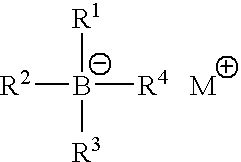Polymerisation initiators, polymerisable compositions, and uses thereof for bonding low surface energy substrates
a technology of initiators and compositions, applied in the direction of adhesives, thin material processing, synthetic resin layered products, etc., can solve the problems of special handling, poor shelf stability, and difficulty in achieving the effect of improving the impact resistance and peel resistance of the bond, maintaining adhesive strength, and improving the impact resistance of the bond
- Summary
- Abstract
- Description
- Claims
- Application Information
AI Technical Summary
Benefits of technology
Problems solved by technology
Method used
Image
Examples
example 1
Initiator Component (Part A)
[0097]Sodium tetraethyl borate (1 g) was mixed with trimethylolpropane tris(3-(2-methylaziridino) propionate thickened with 5% by weight of fumed silica available commercially under the trade name Aerosil R972 from Degussa (25 g) and dissolved by stirring for approximately two hours.
Adhesive Component (Part B)
[0098]A slurry comprising a core-shell toughner (100 g), available commercially under the tradename Blendex 360 from GE Speciality Chemicals, tetrahydrofuriuryl methacrylate (249.5 g), 2-ethylhexyl methacrylate (83.2 g), 2-acryloyloxyethyl maleate (67.3 g) and glass spheres available commercially from Aldrich was stirred with a high shear mixer for several hours until a homogeneous dispersion was obtained.
Adhesive
[0099]The initiator component A (5 g) and adhesive component B (45 g) were packaged respectively into the two syringes of a MIXPAC System 50 1:10 volume ratio 50 ml dual syringe applicator having a 1:10 volume ratio between the syringes hold...
example 2
Initiator Component (Part A)
[0102]Lithium phenyl triethyl borate was prepared1 by reacting 10 mls triethyl borane (1 Molar in THF) in 30 mls of N-Hexane with 5.6 mls of phenyl lithium (1.8M in cyclohexane / ether) added dropwise over a ten minute period under a nitrogen atmosphere at −85° C. to −90° C. The resulting solution was stirred mechanically for 15 minutes at −85° C. to −90° C. and allowed to return to room temperature and stirred for a further hour. The solvents were removed and trimethylolpropane tris(3-(2-methylaziridino)) propionate thickened with 5% by weight of fumed silica Aerosil R972 manufactured by Degussa (3 g).
[0103]1. J. Polymer Science Part A Polym. Chem. 1996,34,13 p.
Adhesive Component (Part B)
[0104]The adhesive component was prepared as in Example 1.
Adhesive
[0105]A mixed adhesive composition was prepared as in Example 1. The mixed adhesive composition was tested on a range of subtrates as outlined in Example 1. The bond strengths are presented in the table belo...
example 4
Initiator Component (Part A)
[0112]Tetra methyl ammonium phenyl triethyl borate (0.5 g) prepared1 as outlined in the literature was added to trimethylolpropane tris(3-(2-methylaziridino))propionate thickened with 5% by weight of fumed silica Aerosil R972 manufactured by Degussa (4.5 g).
[0113]1. J. Polymer Science Part A Polym. Chem. 1996,34,13 p
Adhesive Component (Part B)
[0114]A slurry comprising a core-shell toughener (100 g), available commercially under the tradename Blendex 360 from GE Specialty Chemicals, tetrahydrofurfuryl methacrylate (249.5 g), 2-ethylhexyl methacrylate (83.2 g) and 2-acryloyloxyethyl maleate (67.3 g) was stirred with a high shear mixer for several hours until a homogeneous dispersion was obtained.
Adhesive
[0115]The mixed adhesive composition was prepared as in Example 1. The mixed adhesive composition was tested on a range of substrates as outlined in Example 1. The bond strengths are presented in the table below.
[0116]
Shear StrengthsSubstratesMPaPolyethylene...
PUM
| Property | Measurement | Unit |
|---|---|---|
| room temperature | aaaaa | aaaaa |
| room temperature | aaaaa | aaaaa |
| spacing | aaaaa | aaaaa |
Abstract
Description
Claims
Application Information
 Login to View More
Login to View More - R&D
- Intellectual Property
- Life Sciences
- Materials
- Tech Scout
- Unparalleled Data Quality
- Higher Quality Content
- 60% Fewer Hallucinations
Browse by: Latest US Patents, China's latest patents, Technical Efficacy Thesaurus, Application Domain, Technology Topic, Popular Technical Reports.
© 2025 PatSnap. All rights reserved.Legal|Privacy policy|Modern Slavery Act Transparency Statement|Sitemap|About US| Contact US: help@patsnap.com



